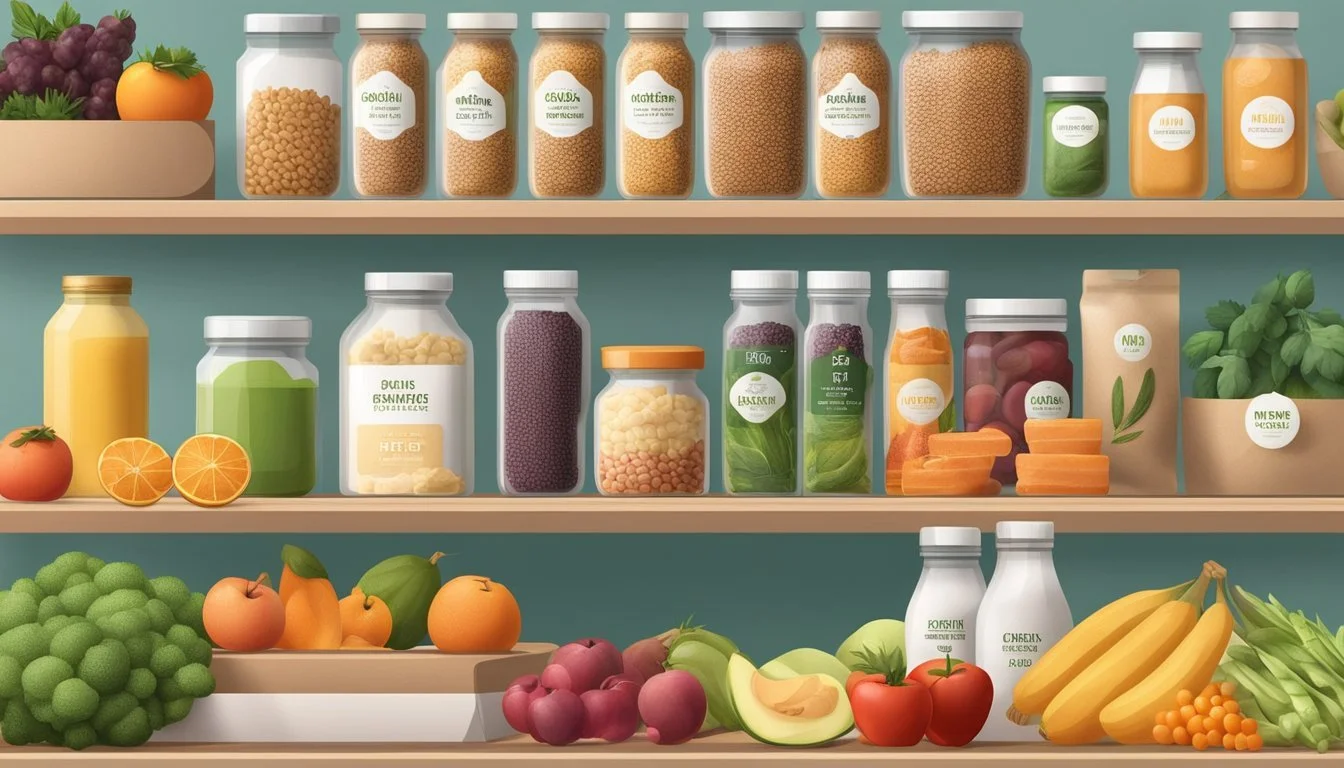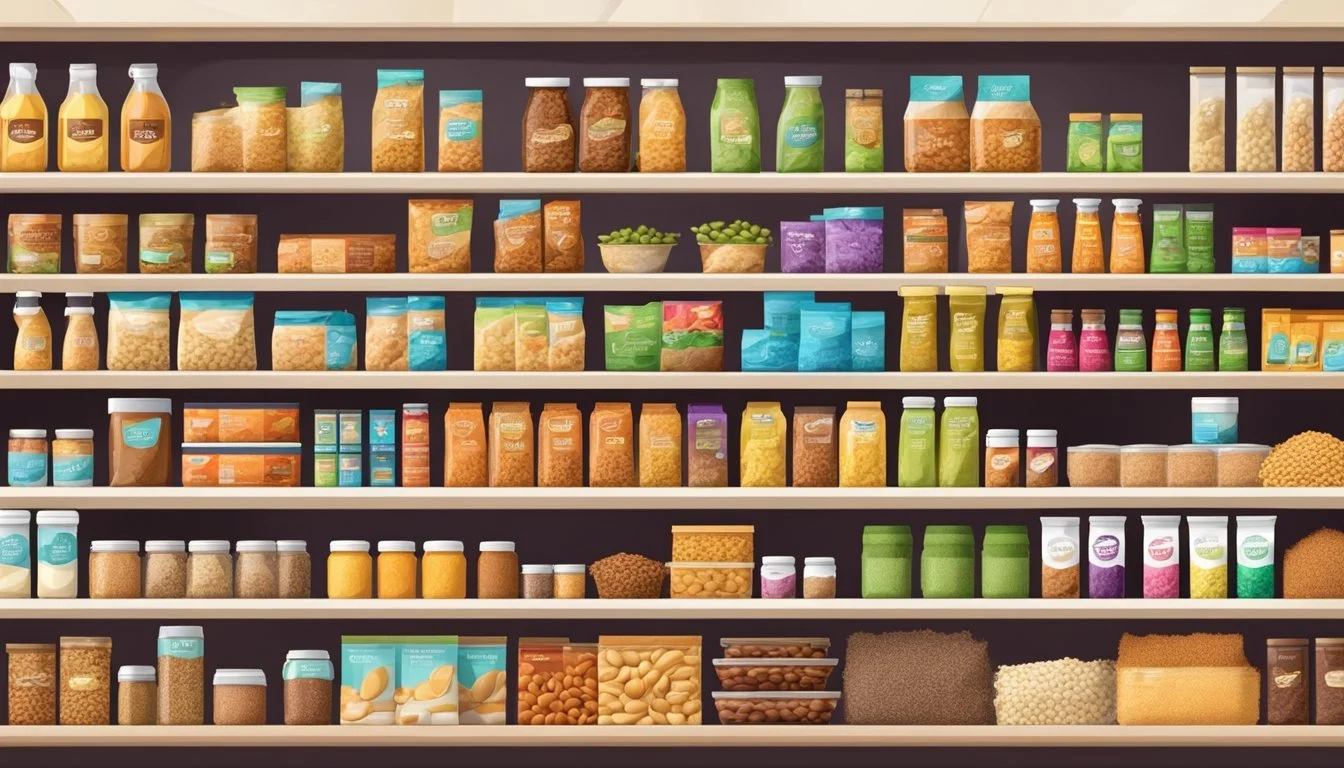The Best Grain-Free Products on the Market Today
Top Picks for Health-Conscious Consumers
Understanding the growing demand for grain-free products, consumers are increasingly seeking alternatives to traditional grain-based foods. Driven by dietary needs, personal health goals, or lifestyle choices such as paleo, Whole30, or gluten-free diets, the market has seen an emergence of innovative grain-free options. These products often focus on using nutrient-dense ingredients to offer a balance of taste and health benefits.
One of the significant segments witnessing this surge is the snacks category, where grain-reliant items like tortilla chips and pretzels are being reinvented. Companies are now producing grain-free versions that are not only matching the growth rates of their conventional counterparts but, in some instances, exceeding them. Similarly, the bakery sector has also adapted, with several brands gaining recognition for their grain-free breads that utilize organic, wholesome ingredients to cater to health-conscious consumers.
It's evident that grain-free products are carving a niche for themselves, and discerning shoppers are willing to explore these alternatives. This move towards grain-free options doesn't compromise on flavor or satisfaction but instead opens a new avenue for nutritionally rich foods that align with various dietary frameworks. Whether for medical reasons or a chosen lifestyle, the best grain-free products on the market today provide ample choice to those looking to diversify their eating habits.
The best grain-free products on the market today offer a diverse array of flavorful and nourishing options, catering to a wide range of dietary preferences and health goals. Whether individuals are following a grain-free keto lifestyle, seeking grain-free plant-based protein options, or planning for a grain-free barbecue picnic, these products provide a convenient and health-conscious solution.
Understanding the importance of essential nutrients such as grain-free calcium vitamin D can contribute to supporting overall well-being and aligning with a grain-free endurance meal plan. Additionally, embracing the best grain-free energy bars can offer a satisfying and convenient way to fuel an active lifestyle, ensuring that individuals have the necessary sustenance for optimal performance.
These products are a testament to the ongoing grain-free evolution, providing a wealth of options to support diverse dietary needs and preferences. Embracing the best grain-free products on the market today offers a fulfilling and health-conscious approach to nourishment, ensuring that flavorful and nourishing options are readily available for individuals to enjoy.
Understanding Grain-Free Products
In recent years, grain-free products have risen in prominence, offering alternative food options for those with specific dietary needs or preferences. This section explores what defines these products and their significance for individuals with health conditions that necessitate such diets.
Defining Grain-Free
Grain-free products exclude all types of grains, including wheat, rice, corn, barley, and oats. They instead utilize ingredients such as almond flour, coconut flour, and seed-based flours. These products cater to people adhering to specific diets, like the Paleo diet, which emulates the eating patterns of our pre-agricultural ancestors, or the Whole30 program, a month-long dietary reset that eliminates certain food groups.
The Importance of Grain-Free Diets for Specific Health Conditions
For individuals with celiac disease, a strict grain-free diet is imperative as their bodies cannot tolerate gluten, a protein found in many grains. Similarly, folks with non-celiac gluten sensitivity also benefit from these products despite the lack of a celiac diagnosis.
Beyond gluten-related disorders, grain-free diets may assist those dealing with Irritable Bowel Syndrome (IBS) or aspects of heart disease, where reducing inflammation is key. The Autoimmune Protocol (AIP) diet, which includes grain-free choices, aims to reduce inflammation and aid in the management of autoimmune diseases. All these dietary approaches use grain-free products as they can contribute to symptom relief and overall wellness for those with these conditions.
Nutritional Advantages of Grain-Free Products
Grain-free products often cater to specific dietary needs while providing essential nutrients. They ensure that individuals receive an adequate intake of protein, fiber, vitamins, and minerals, which are vital components of a well-rounded diet.
Protein and Fiber Content
Grain-free products frequently incorporate ingredients like legumes, tofu, tempeh (What wine goes well with tempeh?), and seeds, which contribute to a high protein content. This can be particularly beneficial for individuals seeking to maintain or increase muscle mass, as well as for those looking to manage their weight effectively. Legumes, such as lentils and chickpeas, not only offer high protein amounts but are also rich in dietary fiber. Fiber supports digestive health and aids in providing a sense of fullness, which can assist with weight control.
Examples of protein-rich, grain-free products:
Legume-based pasta
Tofu and tempeh
Meat and seafood products
Vitamin and Mineral Enrichment
One of the advantages of many grain-free products is their enrichment with essential vitamins and minerals. Ingredients such as nuts, seeds, and various dairy and plant-based products are not just nutrient-dense but also serve as excellent sources of minerals like calcium and magnesium, along with vitamins including Vitamin E and B vitamins. These nutrients play crucial roles in bone health, energy production, and overall metabolic function.
Nutrient-dense, grain-free ingredients often found in products:
Seeds (flaxseeds, sunflower seeds)
Dairy products (cheese, yogurt)
Plant-based milks (almond milk, coconut milk)
By opting for grain-free products that prioritize these nutrient-rich ingredients, individuals can support a diverse and healthful diet.
Popular Grain-Free Ingredients
Grain-free products often incorporate a diverse range of ingredients to provide nutritional benefits and maintain desirable textures and flavors. Ingredients like nuts, seeds, legumes, and various innovative grain alternatives play a crucial role in formulating these products.
Nuts and Seeds as Alternatives
Nuts such as almonds are commonly ground into flour to create a base for grain-free goods. Almond flour is especially prevalent due to its fine texture and rich flavor. Seeds, including chia seeds, flax seeds, and sunflower seeds, offer a wealth of nutrients, like Omega-3 fatty acids, and act as binding agents in the absence of grains.
Key ingredients: Almond flour, chia seeds, flax.
Legumes and Their Benefits
Legumes such as chickpeas and lentils are high in protein and fiber, making them ideal substitutes in grain-free products. These ingredients are often used to form flours or as whole components in snacks and meals, imparting a pleasant taste and enhanced nutritional profile.
Primary benefits: High protein, fiber-rich.
Innovative Grain Replacements
Grain alternatives, like buckwheat, quinoa, and millet, are not true cereals but are often associated with similar uses. These pseudocereals can be ground into flours or used whole, providing texture and nutrition without the presence of traditional grains. Tapioca and cassava are starchy ingredients derived from tropical roots, frequently used to add chewiness to gluten-free baking.
Noteworthy examples: Buckwheat, quinoa, tapioca.
Healthy Fats in Grain-Free Products
Healthy fats such as those found in coconut and olive oil enrich grain-free products with taste and texture benefits. They also contribute positively to the nutritional content, offering an array of fatty acids essential for health. Coconut oil can be a key ingredient in dairy-free options due to its creamy consistency and subtle flavor.
Healthful fats: Coconut oil, olive oil.
Exploring Grain-Free Product Varieties
Grain-free diets have catalyzed the creation of a diverse range of products, offering alternatives for nearly any traditional grain-based food. Manufacturers are innovating to cater to the grain-free trend without sacrificing taste or texture.
Savory Snacks and Crackers
The savory snacks (What wine goes well with savory snacks?) market has been revolutionized with grain-free options. Crackers made from almond flour or a blend of seeds have become popular for their nutrient-dense profiles and satisfying crunch. Brands like Simple Mills offer almond flour crackers that are not only grain-free but also free from gluten and artificial flavors.
Baked Goods and Pastries
Even without traditional flours, consumers can enjoy pastries and baked goods. Grain-free cookies and pizza crusts are now readily available at many health food stores. Utilizing ingredients such as coconut flour and arrowroot, companies succeed in maintaining the beloved textures of these treats. For example, baking mixes from brands like Bob's Red Mill provide an easy option for creating grain-free pastries at home.
Pasta and Noodles Alternatives
Grain-free alternatives to pasta come in various forms, including those made from legumes like chickpeas or lentils. These products offer high protein content and a pasta-like experience. One notable option is Banza's chickpea pasta, which boasts a similar taste and texture to traditional noodles.
Breakfast Cereals and Bars
Breakfast cereals and bars have seen significant innovation in the grain-free sector. Nature’s Path offers a grain-free maple almond granola featuring a blend of seeds, nuts, and natural sweeteners like maple syrup, proving that a satisfying and convenient breakfast can align with grain-free dietary needs. Additionally, Forager Project and Bob's Red Mill produce grain-free hot cereals and bars for a quick and nourishing start to the day.
Evaluating Grain-Free Product Quality
When choosing grain-free products for dogs, it's essential to scrutinize ingredient labels, consider organic and non-GMO options, and assess texture and taste as these factors greatly influence the quality and nutritional value of the food.
Ingredient Labels and Fillers
Ingredient labels reveal the true contents of dog food. High-quality grain-free products often list real meats or meat meals like salmon meal or pork meal as their primary ingredients, followed by wholesome vegetables and legumes. Consumers should be wary of foods with a long list of unrecognizable items or excessive usage of fillers like tapioca, which offer less nutritional value.
Organic and Non-GMO Options
Organic grain-free products avoid the use of synthetic pesticides and GMOs, ensuring a purer diet for dogs. When organic ingredients are prioritized, it generally indicates a commitment to quality and sustainability. Non-GMO options can add a layer of reassurance for pet owners concerned about genetic modifications in their dog's diet.
Texture and Taste Considerations
The texture and taste of grain-free dog food can impact a dog's willingness to eat and the owner's satisfaction with the product. Quality grain-free dog foods should have a palatable texture that appeals to dogs, whether it's a crunchy kibble or a soft, wet food. Flavor profiles derived from natural sources like real meats and vegetables are often more appealing and healthier for dogs.
Health Conscious Shopping for Grain-Free
As consumers seek healthier lifestyles, grain-free products have become a staple for those attentive to carbohydrate intake and gluten sensitivity. Emphasizing whole-food ingredients and minimal processing, these products cater to both nutritional value and dietary inclusivity.
Identifying Low-Carb and Gluten-Free Options
Consumers should look for products that are explicitly labeled as low-carb or gluten-free. Such items often substitute traditional grains with nuts, seeds, and alternative flours like almond or coconut flour. For instance, a popular gluten-free granola may contain nuts, seeds, and natural sweeteners. They should inspect ingredient lists for hidden sources of carbs or gluten, ensuring compliance with their nutritional goals.
Shopping With Dietary Restrictions in Mind
A successful grain-free shopping experience must accommodate not just the absence of grains but also other common restrictions. Many grain-free products also cater to dairy-free or soy-free diets by using ingredients such as nut butters or coconut aminos. Shoppers should review product certification labels, such as Paleo or Whole30, which often indicate that a product is grain-free and adheres to specific dietary guidelines.
Finding Products with No Added Sugars
It is essential for shoppers to identify grain-free products with no added sugars to maintain a well-rounded diet.
Check labels for natural sweetening ingredients: fruits, monk fruit, or stevia
Beware of sugar alcohols and artificial sweeteners if purity of ingredients is a priority
By prioritizing products with whole, unprocessed ingredients, individuals can enjoy the taste and nutritional benefits of grain-free options without unnecessary sugars.
Sustainable and Ethical Practices
When seeking grain-free products, consumers are increasingly attentive to the sustainability and ethical practices of the companies from which they purchase. This section delves into how certain brands are supporting regenerative agriculture and prioritizing sustainability through their business practices.
Supporting Regenerative Agriculture
Regenerative agriculture is a system of farming principles that enhances the health and vitality of farmland. Brands like Thrive Market actively support these practices by offering products that are sourced from farms that prioritize soil health, water management, and biodiversity. For example, they provide a range of grain-free products like pulses—beans, lentils, chickpeas—that are cultivated using methods that reduce the need for chemical fertilizers and pesticides, thus fostering organic stewardship of the land.
Purchasing from Brands that Value Sustainability
Customers can also have a positive impact by choosing brands like Simple Mills, which places a strong emphasis on sustainability. Simple Mills products stand out not only for their grain-free recipes but also for their commitment to environmentally conscious practices.
Packaging: They aim to reduce their environmental footprint through packaging. By 2025, Simple Mills endeavors to have all packaging be recyclable, compostable, or reusable.
Sourcing: Their ingredients are predominantly organic, reducing the reliance on synthetic agricultural chemicals and thus promoting healthier ecosystems.
When shopping for grain-free goods, consumers should look for brands that transparently communicate their sustainability efforts, ensuring that their purchases align with their personal values and contribute to a more sustainable planet.
Integrating Grain-Free into Everyday Life
Adopting a grain-free lifestyle can be streamlined with strategic meal planning and by finding products that balance convenience with nutrition. This approach ensures that individuals maintain a varied and satisfying diet that supports daily health, while being mindful of protein and fiber intake.
Meal Planning with Grain-Free Products
When individuals plan meals, it is crucial to consider the nutritional profile of grain-free products to meet their daily requirements. High-protein and high-fiber grain-free options can replace traditional grains without sacrificing satiety or nutrients. A typical meal plan might include:
Breakfast: A bowl of grain-free hot cereal made with nuts and seeds, rich in fiber and protein to start the day.
Lunch: Salads topped with grilled chicken or roasted meats (What wine goes well with roasted meats?), prepared ahead for convenience, provide a midday protein boost.
Dinner: Vegetable stir-fries with meat or tofu, using coconut aminos as a grain-free sauce base, offer a balanced end-of-day meal with ample nutrients.
Meal frequency should maintain consistent energy levels, aiming for three main meals and potentially two grain-free snacks, like nut bars, throughout the day.
Balancing Convenience and Nutrition
The market offers a variety of grain-free products that are both convenient and nutritious. When purchasing these items, consumers should check labels for caloric content and nutritional benefits to ensure they align with their health goals. Examples include:
Ready-to-eat snacks: Grain-free crackers made from seeds and vegetables
Baking mixes: Coconut or almond flour for fiber-rich baking that can be prepared quickly
Plant milks: Almond or coconut milk which serve as grain-free alternatives to traditional oat or rice milks
These products can be seamlessly integrated into one's diet, reducing the time spent on food preparation while still catering to a grain-free lifestyle.
The Future of Grain-Free Products
The transition towards grain-free products is evident in market sales and consumer demand, indicating a significant shift in the food industry. The innovation in grain alternatives and the incorporation of these options in modern diets suggest a sustainable trend rather than a passing fad.
Innovation in Grain Alternatives
Manufacturers are exploring beyond traditional grains, tapping into a diverse range of plant-based substitutes to meet rising consumer demand for grain-free options. They focus on ancient grains like millet—naturally gluten-free with a mild flavor—and seeds such as pumpkin and sunflower to create products with a robust nutritional profile while maintaining desirable textures and tastes. These grain alternatives are often utilized in the form of flours for breads, wraps, and pastas or as whole ingredients in granolas and cereals.
Key Grain Alternatives:
Millet: A gluten-free grain substitute high in fiber and vitamins, available as a whole grain or flour.
Seeds: Pumpkin, sunflower, and chia seeds contribute to crunchy, nutrient-dense alternatives in snacks.
The Role of Grain-Free in Modern Diets
Grain-free products are carving a niche within modern diets focused on whole foods and minimally processed ingredients. Consumers gravitate towards these products for their enhanced nutritional profiles, offering a balance of proteins, fibers, and healthy fats. This movement aligns with the push for transparency in labeling and a pivot from heavily processed foods to options that cater to dietary restrictions or preferences, such as paleo and Whole30 diets.
Dietary Trends Influencing Grain-Free Choices:
Plant-Based Diets: An increasing number of consumers adopting plant-based lifestyles seek grain-free options as part of their diet.
Whole Foods Approach: A whole foods approach to eating prioritizes minimally processed foods with a clear, traceable origin.
As the market continues to innovate and cater to health-conscious consumers, grain-free products are likely to evolve, delivering not only on taste but also on the promise of nutritional benefits.








